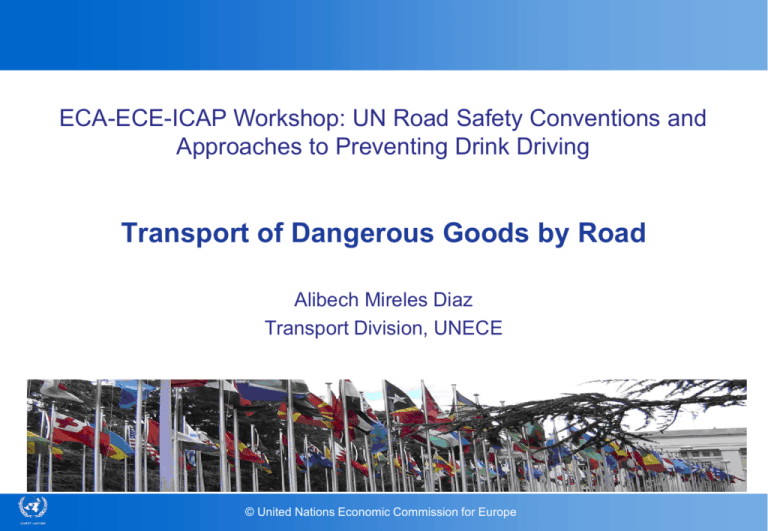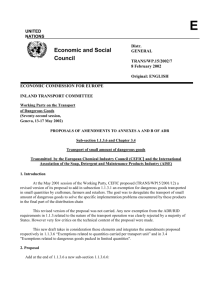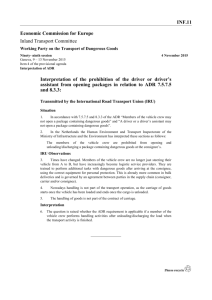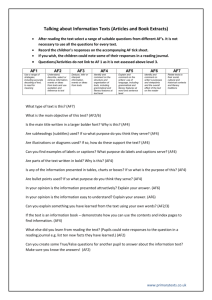Transport of Dangerous Goods by Road
advertisement

ECA-ECE-ICAP Workshop: UN Road Safety Conventions and Approaches to Preventing Drink Driving Transport of Dangerous Goods by Road Alibech Mireles Diaz Transport Division, UNECE © United Nations Economic Commission for Europe Contents • • • ‒ ‒ ‒ • • ‒ • ‒ • Introduction Packagings and tanks Emergency response Marks Labels Placards Transport operations Driver training Driver training certificates Vehicle construction and approval Vehicle certificates ADR © United Nations Economic Commission for Europe 2 Introduction Dangerous goods: Are produced and transported in very large quantities Cover a very large range of products Present risks for the population in general, property and the environment (at all stages of their lifecycle) © United Nations Economic Commission for Europe 3 Introduction Dangerous Goods (examples) Class 1: Explosives •Military ammunitions, bombs (all types) •Industrial explosives (dynamite) •Fireworks © United Nations Economic Commission for Europe 4 Introduction Class 2: Divisions 2.1, 2.2 and 2.3 • Gases compressed, liquefied or refrigerated • Div. 2.1: Flammable gases (propane, LPG, cigarette lighters) • Div. 2.2: Non-flammable, non-toxic gases (air, oxygen, nitrogen, helium) • Div.2.3: Toxic gases (ammonia, chlorine) © United Nations Economic Commission for Europe 5 Introduction Dangerous Goods (examples) Class 3: Flammable liquids • Petroleum products, paints, alcoholic beverages © United Nations Economic Commission for Europe 6 Introduction Dangerous Goods (examples) Class 4: Div. 4.1, 4.2 and 4.3 • Div. 4.1: Flammable solids (Sulphur, matches) • Div. 4.2: Substances liable to spontaneous combustion (phosphorus; fish meal, seed cake) • Div. 4.3: In contact with water emit flammable gases (metal powders; sodium) © United Nations Economic Commission for Europe 7 Introduction Dangerous Goods (examples) Class 5: Div. 5.1 and 5.2 • Div. 5.1: Oxidizing substances (Ammonium nitrate fertilizers, hydrogen peroxide, bleaching agents) • Div. 5.2: Organic peroxides (Dibenzoyl peroxide, catalysts for polyester resin) © United Nations Economic Commission for Europe 8 Introduction Dangerous Goods (examples) Class 6: Div. 6.1 and 6.2 • Div. 6.1: • Div. 6.2: Toxic substances (Sodium cyanide, pesticides) Infectious substances (Cultures for bacteria, viruses, etc; medical diagnostic specimens, medical wastes) © United Nations Economic Commission for Europe 9 Introduction Dangerous Goods (examples) Class 7: Radioactive material • Nuclear fuel, • Uranium hexafluoride, • Medical radioisotopes © United Nations Economic Commission for Europe 10 Introduction Dangerous Goods (examples) Class 8: Corrosive substances • Sulphuric acid, Caustic soda, Car batteries © United Nations Economic Commission for Europe 11 Introduction Dangerous Goods (examples) Class 9: Miscellaneous • Environmentally hazardous substances; • Mobile phone/computer batteries… © United Nations Economic Commission for Europe 12 Introduction © United Nations Economic Commission for Europe 13 Introduction 1978, Los Alfaques (Spain) •Substance involved: 43 m3 liquefied propylene; •Mode of transport: by road; •217 people killed; 400 yards devastated in all directions. 1998, Yaounde (Cameroun): •Substance involved: petroleum products; •Mode of transport: by rail; •220 people killed; 130 injured. © United Nations Economic Commission for Europe 14 Introduction • Accidents have also negative effects on the environment. • Well-known examples are oil spillages: – Torrey-Canyon; – Amoco Cadiz; – Exxon Valdez; – Erika… • Although small spillages of highly toxic substances may also have disastrous effects. © United Nations Economic Commission for Europe 15 UN Regulatory Framework IMO ICAO RID/ADR/ADN Joint Meeting (WP.15/AC.1) OTIF WP.15 WP.15/AC.2 UNMR Rev.18 (adopted in Dec. 2012) Provisions implemented as from January 2015 © United Nations Economic Commission for Europe 16 Packagings and tanks Classic packagings • Up to 400 kg/450 l, such as drums, jerricans, boxes, bags, etc. © United Nations Economic Commission for Europe 17 Packagings and tanks IBCs and large packagings © United Nations Economic Commission for Europe 18 Packagings and tanks Tanks © United Nations Economic Commission for Europe 19 Hazard labels Affixing appropriate hazard label(s) on the packages: 3 4 4 4 5.1 5.2 © United Nations Economic Commission for Europe 20 Marks Marking the UN (identification) number of the goods on the package, and the “Proper Shipping Name” • • UN No.: 3082 Proper shipping name: ENVIRONMENTALLY HAZARDOUS SUBSTANCE, LIQUID, N.O.S. © United Nations Economic Commission for Europe 21 Placards Affixing placards on the cargo transport units (vehicles, wagons, containers, tanks) and displaying, either on these placards or on separate orange plates, the UN identification number; © United Nations Economic Commission for Europe 22 Placards Mark for carriage at elevated temperature Fumigation warning mark COOLANT/CONDITIONER warning mark for vehicles and containers Placard for radioactive material (class 7) Environmentally hazardous substance mark 23 Placards ADR orange-coloured plate marking with hazard identification number and UN number Hazard identification numbers The hazard identification number consists of two or three figures. In general, the figures indicate the following hazards: 2. Emission of gas due to pressure or to chemical reaction 3. Flammability of liquids (vapours) and gases or selfheating liquid 4. Flammability of solids or self-heating solid 5. Oxidizing (fire-intensifying) effect 6. Toxicity or risk of infection 7. Radioactivity 8. Corrosivity 9. Risk of spontaneous violent reaction Doubling of a figure indicates an intensification of that particular hazard. Where the hazard associated with a substance can be adequately indicated by a single figure, this is followed by zero. If a hazard identification number is prefixed by the letter "X", this indicates that the substance will react dangerously with water. © United Nations Economic Commission for Europe 24 Transport Hazard Communication: documentation • Multimodal Transport document • Providing details of the dangerous goods offered for shipment: • UN No., proper shipping name, hazard class and subsidiary hazard, packing group • Number and kind of packages • Shipper’s declaration • Shipper/consignor/consignee 25 Emergency response Emergency response information For consignments for which a dangerous goods transport document is required, appropriate information shall be immediately available at all times for use in emergency response to accidents and incidents involving dangerous goods in transport. The information shall be available away from the packages containing the dangerous goods and immediately accessible in the event of an accident or incident. Methods of compliance include: 1.Appropriate entries in the transport document; or 2.Provision of a separate document such as a safety data sheet; or 3.Provision of a separate document, such as the International Civil Aviation Organization (ICAO) “Emergency Response Guidance for Aircraft Incidents Involving Dangerous Goods” or the International Maritime Organization (IMO) “Emergency Procedures for Ships Carrying Dangerous Goods” and “Medical First Aid Guide in Accidents Involving Dangerous Goods”, for use in conjunction with the transport document. 26 Emergency response: North America The Emergency Response Guidebook has several sections based on the color of the pages: 1.The white section provides directions, emergency phone numbers, general information and guidance. 2.The yellow section lists the chemicals based on their four digit ID and guide numbers. 3.The blue section lists the chemicals in alphabetical order (a way for you to get the four digit UN number and the guide page number also). 4.The orange section is the guide pages which provide emergency chemical information, actions to take, personal protective equipment guidelines, fire extinguishing material recommendations and isolation/evacuation distances; these are known as the “guide pages”. 5.The green section provides distances for isolation and protective action (evacuation and shelter-in-place distances) for chemical that are gases or will travel as gases and a list of water reactive chemicals that will give off toxic gases when in contact with water. Emergency response The CEFIC Emergency Response Intervention Cards (ERICards or ERIC's) provide guidance on initial actions for fire crews when they first arrive at the scene of a chemical transport accident without having appropriate and reliable product specific emergency information at hand. Emergency Response Intervention Cards information is structured according to a standard format: 1. Page header with substance name, UN number, hazard number, ADR label, ADR class, classification code (hazard identification number), packing group and ERICard number 2. Properties 3. Dangers 4. Personal protection http://www.ericards.net/ 5. Emergency response ‒ General measures ‒ Measures fabric outlet ‒ Measures in case of fire (if material involved) 6. First Aid 7. Special precautions in the recovery of dang. goods 8. Precautions for the use of aid ‒ Removal of protective clothing (Decon P) ‒ Cleaning of equipment (Decon G) Training (UN Model Regulations) • Human errors are the main cause of accidents. • The UN Model Regulations (and related legal instruments): (a) require training of all persons engaged in the transport of dangerous goods: – in the contents of dangerous goods requirements; – commensurate with their responsibilities; and (b) lay down specific provisions regarding: – general awareness/familiarization training, – function specific training, – safety training, records of training, etc. • Training can be provided by the employer © United Nations Economic Commission for Europe 29 Training RID/ADR/ADN •ADR requires: – Training for drivers of road vehicles (ADR driver training certificate) (initial training and refreshers courses); and – Specific additional training for drivers of tank vehicles, vehicles carrying explosives and vehicles carrying radioactive material. •ADN requires: – experts trained every 5 years be on board chemical and gas tankers •RID/ADR/ADN also require the appointment of a dangerous goods safety adviser (DGSA) holding a vocational training certificate. © United Nations Economic Commission for Europe 30 Means of transport SOLAS, MARPOL certificates ADR certificate ADN certificate © United Nations Economic Commission for Europe 31 ADR AGREEMENT: – Done on 30 September 1957 – Entered into force on 29 January 1968 ANNEXES A AND B: – Regularly amended since 1968 – Now amended every two years on the basis of UN Recommendations on the Transport of Dangerous Goods – Harmonized with other mode regulations (sea, air, rail, inland waterways) – Latest edition in force since 1 January 2013 © United Nations Economic Commission for Europe 32 48 contracting parties © United Nations Economic Commission for Europe 33 ADR: Structure • Annex A (Parts 1-7), general provisions: – Applicable to the goods themselves (classification, packing, tanks, labelling, documents…) – Relevant for all modes of transport – Directly based on the UN Model Regulations – Nearly identical to: • RID (rail) • ADN (inland waterways) • IMDG Code (sea) • ICAO TI (air) – Conditions for application of additional rules • for reasons other than safety during transport © United Nations Economic Commission for Europe 34 ADR: Structure • Annex B (Parts 8-9) – provisions concerning transport equipment and transport operations specific to road transport • Vehicle crew, including training • Operation and equipment • Supervision of vehicles • Road tunnel restrictions • Construction, approval and inspections of vehicles © United Nations Economic Commission for Europe 35 ADR ADR = Safety + Security + Facilitation – Allows carriers of one country to carry dangerous goods from this country through and to any other Contracting Party country. No additional requirements imposed by transit or destination countries; – – – – – Mutual recognition of certificates: Packaging certificates Vehicle certificates Tank certificates Driver training certificates © United Nations Economic Commission for Europe 36 ADR – Mutual trust and cooperation between Contracting Parties; – High level of safety, but not excessive burden for countries; – Possibility of negotiating derogations with other Contracting Parties (bilateral/multilateral agreements); – Open to all UN Member States (via accession). © United Nations Economic Commission for Europe 37 Working Party on the Transport of Dangerous Goods - WP.15 – All UNECE countries – All UN Member States interested in ADR – Voting rights for UNECE countries and Contracting Parties only © United Nations Economic Commission for Europe 38 ADR: implications for Parties • Administrative procedures for: – packagings, tanks and vehicles approval/certificates – dangerous goods safety adviser certificates – driver training certificates – enforcement (controls and checks; penalties) – cooperation with other Contracting Parties • Notifications to the UNECE secretariat • Regular participation in the Working Party on the Transport of Dangerous Goods (WP.15) © United Nations Economic Commission for Europe 39 ADR: application to domestic traffic • Not required by ADR, but highly recommended – (UNECE Inland Transport Committee, Resolution No. 200, 18.12.1959) • ADR application to domestic traffic ensures: – – – – full compatibility of national and international regulations; better performance of transport operators; better compliance with safety regulations; better enforcement. • European Union: Directive 2008/68/CE (ADR, RID et ADN) © United Nations Economic Commission for Europe 40 Publications http://www.unece.org/trans/publications/ dg_adr_2015.html http://www.unece.org/trans/danger/ publi/adr/adr_roadmap.html http://www.unece.org/transport/resources/publications/transdangerpublidgpublications/2013/recommendations-on-the-transport-of-dangerous-goods-model-regulationsrev18/doc.html © United Nations Economic Commission for Europe 41 Thank you! UNECE Transport Division www.unece.org/trans





